Welcome to another edition of Mighty Marvel Monday!
You know it’s been a slow newsweek when the top Marvel-related link is to George R. R. Martin’s Livejournal post, but I’m actually happy about this, because two Wednesdays ago, a very special comic was finally released, and because of GRRM, I’m able to devote this entire MMM to saying goodbye to Matt Fraction and David Aja’s Hawkeye, after so much waiting.
Well, it feels like that, anyway. In actuality, it was 21 weeks between Hawkeye #21 and Hawkeye #22. But, it was 20 weeks between Hawkeye #20 and Hawkeye #21, and although it was a scant 5 weeks between Hawkeye #19 and Hawkeye #20, it was 18 weeks between Hawkeye #18 and Hawkeye #19.
This is the kind of publishing schedule usually only beloved webcomics can get away with, and something that feels unprecedented in a big publisher like Marvel. Hawkeye #22’s release was just two weeks shy of being a full calendar year after the release of Hawkeye #19. All told, I’ve spent more than a year waiting for these last four issues.
Was it worth it?
Abso-fucking-lutely.
The reason it was worth it is that Fraction and Aja didn’t just write a truly excellent comic. Like all the greats, they pushed the boundaries of what comics can do as a medium. This, more than anything, is what makes this run of Hawkeye greater than the sum of its parts. This, more than anything, is why it will be remembered for generations.
So, this is my long, tear-filled goodbye to Hawkeye.
[Sidenote: You may find it appropriate to listen to Boyz II Men’s “It’s So Hard To Say Goodbye to Yesterday” on repeat, as it was the soundtrack for the majority of my re-reading, and composing.]
In the days of comics past, when ongoing series had issues numbering into the hundreds, it was not uncommon for writers and artists to be rotated out without warning, or even consideration. It’s rare, if not unprecedented in the big two, for writers and artists to be given a chance to wrap up their storylines before the title is handed off to another, especially with this kind of ceremony (and additional pages), but it’s something that I feel needs to be praised, and gratitude expressed to Marvel for allowing it.
Sana Amanat, the editor who started (and finished) with this series, said of it in the final Arrow Mail:
“Hawkeye signaled a shift in the way we told comics at Marvel. Not only stylistically, but story-wise as well.”
While she points to the relatability of Clint Barton as being the major difference, Clint Barton has always been relatable–this is simply the first time we, as readers, were given a chance to relate to him. It redefined what a solo-title could be by answering the most-asked question about superheroes: What do superheroes do when they’re not saving the world?
But more than being a new title requiring very little outside knowledge (and being, therefore, accessible to new fans), Fraction also re-defined Clint Barton, since, it turns out, Clint Barton, aka Hawkeye, the Greatest Sharp-shooter Known To Man, was basically the Rodney Dangerfield of superheroes–he got no respect, which, considering just the period prior to Fraction’s successful reboot, is not particularly surprising.
Hawkeye was another boring white guy who was known primarily through his relationships with much more interesting women, such as Natasha Romanoff. In the decade before Hawkeye, he was killed, killed again, resurrected only to fake his own death and disappear, then reappear during Captain America’s dead-period for Tony Stark to try to convince him to put on Cap’s mantle, which he eventually rejects, only to put on the mantle of Ronin (which was so bad for so many whitewashing reasons). In Hawkeye, Clint Barton is only himself, and further, he is also himself at his most stripped down, out of costume most of the time (and sometimes stripped down even further than that), and it turns out that Clint Barton isn’t just relatable, he’s comedic gold.
But beyond the humor, Hawkeye also tackled a serious issue, making it, in my mind, one of the most feminist comics of the decade. During one of Barton’s dead/faked death periods, Allan Heinberg wrote Young Avengers and created Kate Bishop, who took on the mantle of Hawkeye. When Clint returned to being Hawkeye, this meant that there were now two Hawkeyes. Fraction made a conscious effort to address Kate Bishop and the logistical Hawkeye issue. Although it had been previously addressed (kinda) in Young Avengers #4, Fallen Son: The Death of Captain America #3, and Young Avengers Presents #6, Kate Bishop’s assumption of the Hawkeye name without any kind of modifier (ex. Lady Hawkeye) or creation of an alternate identity, was still a point of contention, until Fraction solved the issue by making it an absolute point of non-contention.
Barton and Bishop refer to each other as Hawkeye in both public and private, as if the use of the title is a shared in-joke between friends.
Their comfort with it implies that we, the readers, should also be comfortable with it. Fraction even goes so far as to split the narrative focus between the two with two separate artists for several months, with the issues by Fraction and Aja focusing on Clint alternating with issues by Fraction and Annie Wu, focusing on Kate.
People who have only read the collected trade paperbacks may be unaware of this alternating narrative shift, which is unfortunate. While it makes a certain amount of narrative sense, it removes the stronger political statement–Hawkeye wasn’t just Clint Barton’s solo-title guest starring Kate Bishop. It was also Kate Bishop’s solo-title guest starring Clint Barton. They shared more than the name, they shared the series.
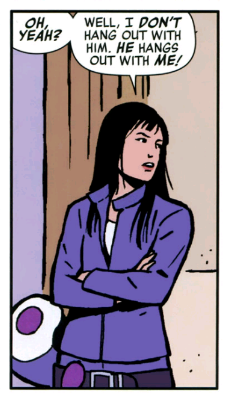 This is what a feminist comic looks like, in the very basic sense of holding both Clint and Kate’s stories as equally worthy.
This is what a feminist comic looks like, in the very basic sense of holding both Clint and Kate’s stories as equally worthy.
[Sidenote: I find Annie Wu’s art for Kate’s issues to be even better than David Aja’s when it comes to representing Kate. Wu manages to capture Kate’s personality and represent her as a fully-formed protagonist in a way that Aja’s work does not. My one stylistic bone to pick with David Aja is that all his women in this title look the same.]
But for all of Clint Barton’s hilarity, for all of Kate Bishop’s awesome, the real star of this series was Lucky, aka Pizza Dog, whose celebrity was perhaps a motivating factor in telling the narrative from Lucky’s point of view in what became known as “the dog comic,” Hawkeye #11.
When I said at the beginning of this that Fraction and Aja changed the medium of comics and pushed boundaries, I was referring to this issue in particular, because Lucky is not anthropomorphized. He’s not suddenly human. He is still a dog, and as a dog, he does not think in language in the same way that humans think in language. In my graduate school days, I had a real soft spot for Jacques Lacan and the Lacanian concepts of the symbolic order as represented through the media of television and film, and Aja and Chris Eliopoulos as letterer created an entirely new Symbolic Order through using actual symbols, in the very literal sense, but also might be thought of as infographics and flow charts.
[Sidenote: I can’t express how excited the symbols, infographics, and flow charts make me as a former instructor of technical writing. If I was still an instructor, I would make Hawkeye #11 required course reading.]
So, we’ve covered the resurrection of Hawkeye, the feminism, Pizza Dog, and the ground-breaking illustrations, but all of those will likely be eclipsed in Fraction and Aja’s legacy by Hawkeye #19.
Hawkeye #19 is extremely important. Not was, is. For years the state of Clint Barton’s hearing was in flux, if it was discussed at all, and though it was entirely within Fraction’s narrative power to not deal with it at all, not only did Fraction address Barton’s hearing issue conclusively, he and Aja explored what that world would sound like–in a comic. There are certain things that only people who have an invisible disability understand, and to see some of that experience made visible is significant.
In Hawkeye #19, Fraction and Aja once again pushed the boundaries of what a comic can be through the use of blank speech bubbles and infographic representations of ASL, or American Sign Language, but the broader legacy is far-reaching. In 2012, Marvel created a superhero called Blue Ear because a little boy said that superheroes don’t wear hearing aids.
Now, so does Hawkeye.
And now, just as Hawkeye has come to an end, so, too, must my long goodbye.
Thank you Marvel, Matt, David, Annie, Chris, and so many others who worked tireless behind the scenes who made this series, and this goodbye, happen. And now, finally, I’m ready to move on to the All-New Hawkeye with Jeff Lemire and Ramon Perez.
Roll the credits.
ICYMI
Our review of Ant-Man can be found here!
Next Week
I try, and fail, to contain my excitement for Fantastic Four.


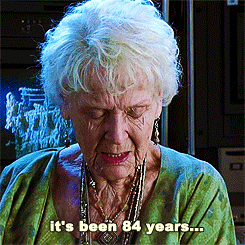
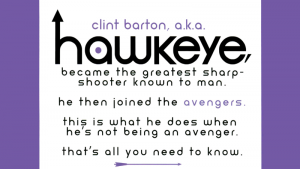
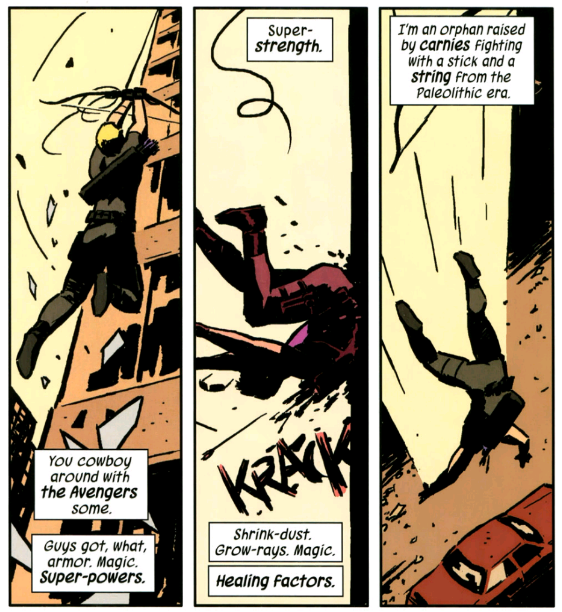
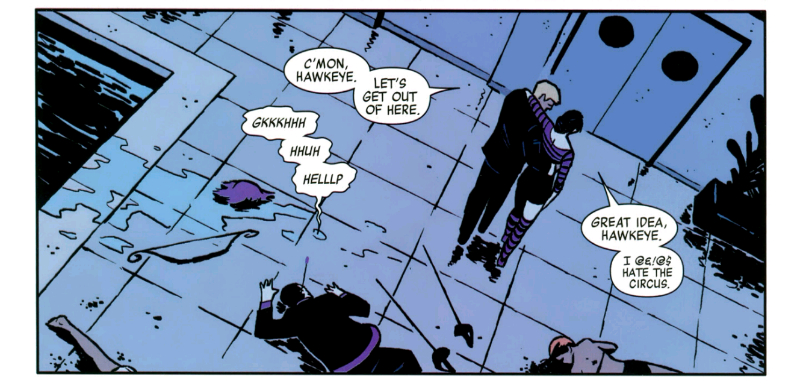
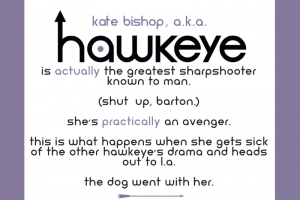




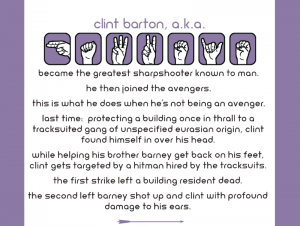


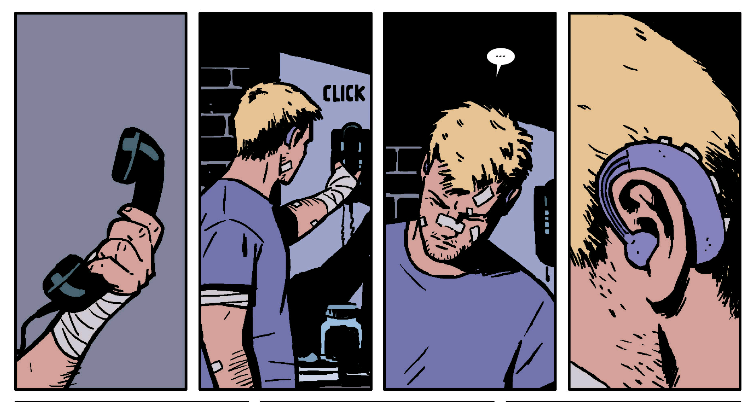


I love that you turned MMM into your goodbye for Hawkeye! I have been reading it via trade so looking forward to the final trade and loving from what I briefly saw what Fraction and Aja are doing with Hawkeye’s disability. Cool, thoughtful, compelling.
Thanks, lady! Slow news weeks are sometimes blessings in disguise 🙂